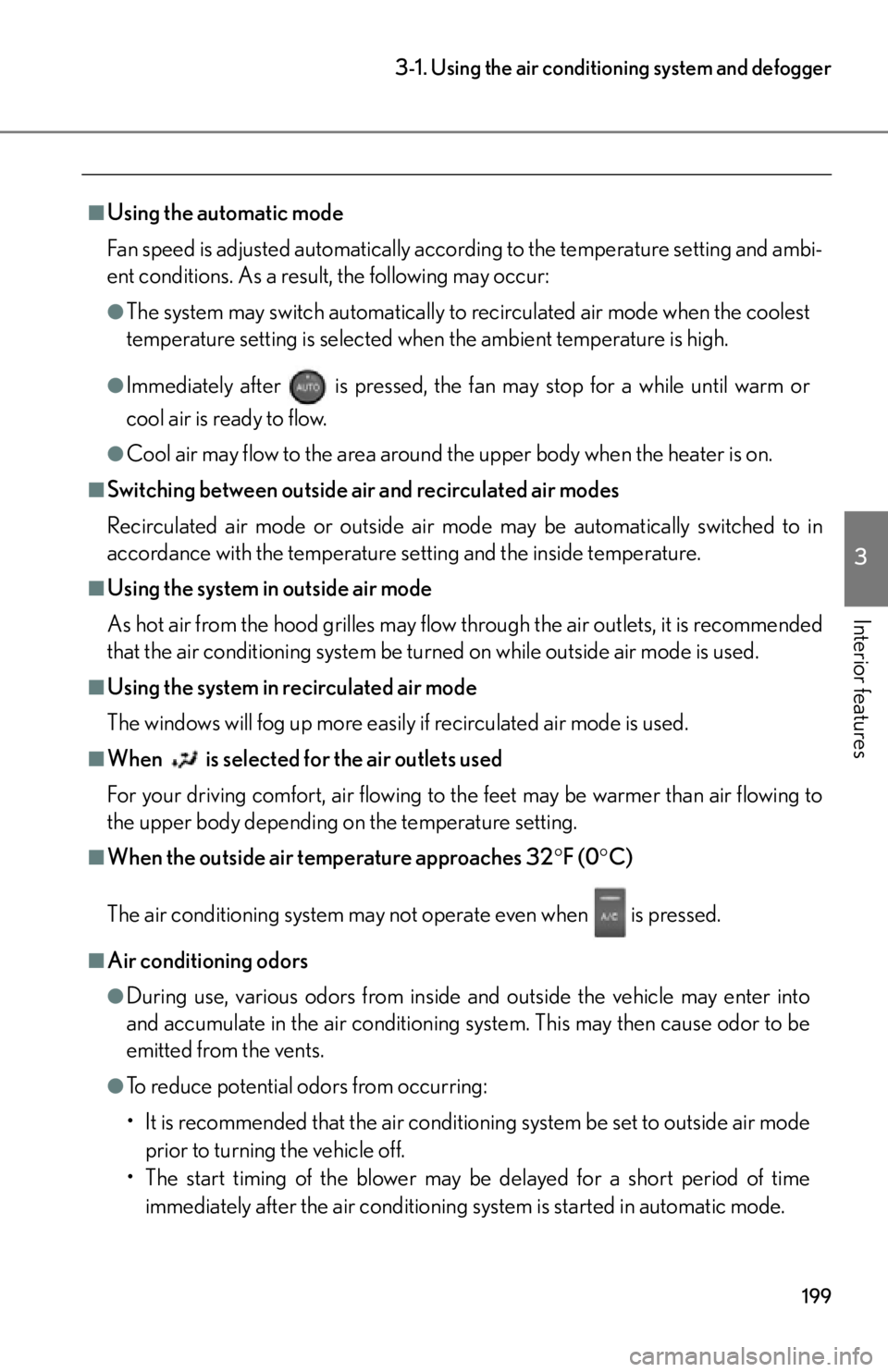Page 34 of 420
32
1-3.Adjustable components (seats, mirrors, steering wheel)
Seats
Seat position switch
Seatback angle switch
Seat cushion (front) angle switch
Vertical height adjustment switch
Seatback fold and return switch (P. 3 3 )
Seat heater temperature adjustment dial
When the dial is rotated, the indicator light comes on.
The higher the number is, the warmer the seat becomes.
Page 36 of 420

34
1-3. Adjustable components (seats, mirrors, steering wheel)
■The seat heaters can be used when
The ignition switch is in the “ON” position.
■When the seat heater is not in use
Set the dial at “0”. The indicator light goes off.
■Seatback fold and return switch
When the doors are closed, the seatback fo ld and return switch cannot be used to
fold the seatbacks. However, the passenge r seat can be returned using the seat-
back fold and return switch even when the door is closed.
■When using the seatback fold and return switch
In order to enable easier loading and un loading of luggage, the seat belt can be
released from its seat belt guide. After pu lling the upper part of the seat belt guide
away from its magnet, release the seat belt.
■Stopping the seat folding operation partway
Operate a seat ad justment switch.
■The auto away function for exiting the driver seat
If the seat is already close to the rearmost position, the auto away function may not
operate when the driver exits the vehicle.
■Customization
The power easy access system can be activated/deactivated.
(Customizable features P. 383)
CAUTION
■Seat adjustment
Do not recline the seat more than necessary when the vehicle is in motion to reduce
the risk of sliding under the lap belt.
If the seat is too reclined, the lap belt may slide past the hips and apply restraint
forces directly to the abdomen or your neck may contact the shoulder belt, increas-
ing the risk of death or serious in jury in the event of an accident.
■Seatback fold and return switch
Never operate the seat fold switch while the seat is occupied, as the occupant may
become jammed in the seat, resulting in serious injury.
Page 37 of 420

35
1-3. Adjustable components (seats, mirrors, steering wheel)
1
Before driving
CAUTION
■If the seat belt guide is disengaged
●Make sure that the seat belt guide is securely fixed before driving.
●After using the seatback fold and return switch, make sure that the seat belt
passes through the seat belt guide.
■Avoiding burns when using the seat heaters
●Use caution when seating the following pers ons in a seat with the seat heater on
to avoid the possibility of burns:
• Babies, small children, the elderly, the sick and the physically challenged
• Persons with sensitive skin
• Persons who are fatigued
• Persons who have taken alcohol or drugs that induce sleep (sleeping drugs,
cold remedies, etc.)
●Do not cover the seat with anything when using the seat heater.
Using the seat heater with a blanket or cushion increases the temperature of the
seat and may lead to overheating.
●Do not use the seat heater more than necessary. Doing so may cause minor
burns or overheating.
NOTICE
■To prevent seat heater damage
Do not put heavy objects that have an unev en surface on the seat and do not stick
sharp objects (needles, nail s, etc.) into the seat.
■To prevent battery discharge
Turn the seat heaters off when the engine is not running.
Page 194 of 420

192
3-1. Using the air conditioning system and defogger
■Using the automatic mode
Fan speed is adjusted automatically accord ing to the temperature setting and ambi-
ent conditions. As a result, the following may occur:
●The system may switch automatically to recirculated air mode when the coolest
temperature setting is selected when the ambient temperature is high.
●Immediately after is pressed, the fan may stop for a while until warm or
cool air is ready to flow.
●Cool air may flow to the area around the upper body when the heater is on.
■Switching between outside air and recirculated air modes
Recirculated air mode or outside air mode may be automatically switched to in
accordance with the temperature setting and the inside temperature.
■Using the system in outside air mode
As hot air from the hood grilles may flow through the air outlets, it is recommended
that the air conditioning system be turned on while outside air mode is used.
■Using the system in recirculated air mode
The windows will fog up more easily if recirculated air mode is used.
■When is selected for the air outlets used
For your driving comfort, air flowing to th e feet may be warmer than air flowing to
the upper body depending on the temperature setting.
■When the outside air temperature approaches 32 F (0C)
The air conditioning system may not operate even when “A/C” is selected on the
operation screen.
■Air conditioning odors
●During use, various odors from inside and outside the vehicle may enter into
and accumulate in the air conditioning sy stem. This may then cause odor to be
emitted from the vents.
●To reduce potential odors from occurring:
• It is recommended that the air conditioning system be set to outside air mode
prior to turning the vehicle off.
• The start timing of the blower may be delayed for a short period of time immediately after the air conditioning system is started in automatic mode.
Page 201 of 420

199
3-1. Using the air conditioning system and defogger
3
Interior features
■Using the automatic mode
Fan speed is adjusted automatically according to the temperature setting and ambi-
ent conditions. As a result, the following may occur:
●The system may switch automatically to recirculated air mode when the coolest
temperature setting is selected when the ambient temperature is high.
●Immediately after is pressed, the fan may stop for a while until warm or
cool air is ready to flow.
●Cool air may flow to the area around the upper body when the heater is on.
■Switching between outside air and recirculated air modes
Recirculated air mode or outside air mode may be automatically switched to in
accordance with the temperature se tting and the inside temperature.
■Using the system in outside air mode
As hot air from the hood grilles may flow through the air outlets, it is recommended
that the air conditioning system be turned on while outside air mode is used.
■Using the system in recirculated air mode
The windows will fog up more easily if recirculated air mode is used.
■When is selected for the air outlets used
For your driving comfort, air flowing to th e feet may be warmer than air flowing to
the upper body depending on the temperature setting.
■When the outside air temperature approaches 32 F (0C)
The air conditioning system may not operate even when
is pressed.
■Air conditioning odors
●During use, various odors from inside and outside the vehicle may enter into
and accumulate in the air conditioning sy stem. This may then cause odor to be
emitted from the vents.
●To reduce potential odors from occurring:
• It is recommended that the air conditioning system be set to outside air mode
prior to turning the vehicle off.
• The start timing of the blower may be delayed for a short period of time
immediately after the air conditioning system is started in automatic mode.
Page 241 of 420
239
4-1. Maintenance and care
4
Maintenance and care
NOTICE
■Cleaning the inside of the rear window
●Do not use glass cleaner to clean the rear window, as this may cause damage to
the rear window defogger heater wires or antenna. Use a cloth dampened with
lukewarm water to gently wipe the window clean. Wipe the window in strokes
running parallel to the heater wires or antenna.
●Be careful not to scratch or damage the heater wires or antenna.
Page 295 of 420
293
4-3. Do-it-yourself maintenance
4
Maintenance and care
■Driver’s side instrument panel
FuseAmpereCircuit
1D-P/W 20 A Power window (driver's side)
2D-PWR SEAT 30 A Power seat (driver's side)
3DRLCK ALT 25 A Main body ECU
4RLY SIG 5 A PANEL
5OBD10 A On-board diagnosis
6AM1 5 AD-ACC, P-ACC, CDS FAN, WIP,
WASH, MIR HTR, D-S/HTR, P-S/
HTR, D-IG1-1, D-IG1-2, D-IG1-3, D-
IG1-4, P-IG1-1, P-IG1-2, P-IG1-3, P-
IG1-4, RR-IG1
7D-S/HTR 15 A Seat heater (driver's side)
8D-ACC
5 A Main body ECU
9R/MIR10 A Outside rear view mirrors
10D-IG1-1 5 A CAN gateway ECU
11D-IG1-4 5 A Seat heater (driver's side)
12D-IG1-25 AMain body ECU, rear hatch, EPS
(Electric Power Steering), tire pres-
sure warning system, charging system,
turn signal lights, emergency flashers
Page 297 of 420
295
4-3. Do-it-yourself maintenance
4
Maintenance and care
■Passenger’s side instrument panel
FuseAmpereCircuit
1P-PWR SEAT 30 A Power seat (passenger's side)
2P-P/W 20 A Power window (passenger's side)
3DISPLAY2 10 A Navigation system
4DISPLAY1 10 A Remote Touch, navigation system, air
conditioning system
5A/C
10 A Air conditioning system
6P- ACC 5 ARemote Touch, navigation system, air
conditioning system, Lexus Enform
7P-CIG
15 A Power outlet
8P-IG1-4 5 A Seat heater (passenger's side)
9P- I G 1 -15 AMultiport fuel injection system/
sequential multiport fuel injection sys-
tem, air conditioning system
10P- I G 1 -3
5 ASRS airbag system, VDIM (Vehicle
Dynamics Integrated Management)
11P- I G 1 -2
5 ANavigation system, air conditioning
system
12ABS MAIN P1 10 A
13ABS MAIN P2 10 A Electronically controlled brake system